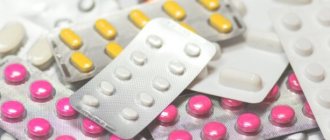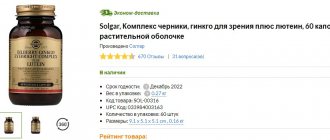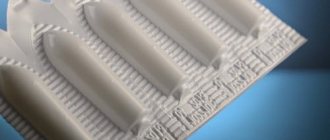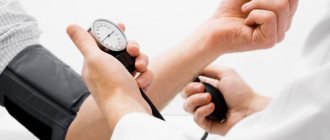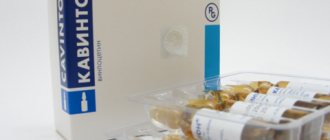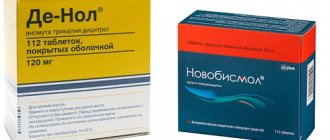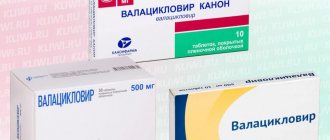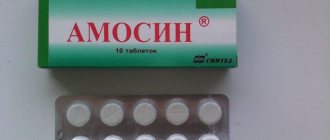Every person at least once in his life has encountered one of the types of the body’s protective reaction to negative factors of the internal and external environment - spastic pain. It occurs due to contraction of smooth muscle tissue, which is present in almost all vital systems: digestive, excretory, musculoskeletal, etc.
Spastic pain often occurs when a dangerous pathology appears, disturbances in the functioning of the nervous system or hormonal changes in men and women. The spasm can affect either one muscle or several groups. During this process, blood flow to the contracted tissues is severely limited. This increases the pain syndrome.
In order to get rid of painful contraction of smooth muscle tissue, medical specialists prescribe targeted drugs - antispasmodics.
Antispasmodics: classification, list of the most popular drugs
Antispasmodics are medications whose main effect is to reduce the number and intensity of spasms and eliminate pain arising from them. They are the first choice drugs for abdominal pain syndrome (stomach pain).
Depending on the nature of the spastic reaction on which these drugs act, antispasmodics are divided into the following groups:
- Neurotropic antispasmodics (M-anticholinergics). They prevent nerve impulses from being transmitted through the autonomic nervous system. A muscle that has not received a physiological or pathological command to contract from the brain relaxes quite quickly. In addition, they may have an additional antisecretory effect. Depending on the mechanism of action, M-anticholinergics are divided into the following groups:
- neurotropic antispasmodics of central and peripheral action. These include drugs containing atropine and belladonna extract;
- Peripheral m-anticholinergics. These include preparations of hyoscine (buscopan), methocynium bromide and priphyria bromide;
- centrally acting antispasmodics. Difacil, aprofen and other drugs with similar active ingredients fall under this classification.
- Myotropic antispasmodics. They influence the processes occurring directly in the contracted muscle. Sometimes spasm is the result of a deficiency or excess of various substances necessary for muscle fibers to function normally, and can also occur due to enzymatic and hormonal activity, for example, during premenstrual syndrome in women. The substances contained in myotropic antispasmodics prevent muscle fibers from contracting, taking a closed position and contracting sharply and intensely. TO The group of myotropic antispasmodics includes the following types of drugs:
- non-selective calcium channel antagonists - pinaveria bromide, otilonium bromide (spasmomen), verapamil;
- phosphodiesterase inhibitors - papaverine, drotaverine (no-shpa), bencyclane;
- sodium channel blockers - mebeverine;
- xanthine derivatives - theophylline, aminophylline, aminophylline, dibazole;
- analogues of cholecystokinin - hymecromone;
- nitrate preparations used in the field of cardiology - nitroglycerin, isosorbide dinitrate, erinite, nitrospray, nitrong.
- There are also combined antispasmodic analgesics that combine various active medicinal substances. As a result, the drug can not only reduce the intensity of spasms and relax smooth muscle tissue, but also relieve pain with the help of an analgesic component. Such medications include benalgin, spasmalgon, sedalgin-neo.
- Often, infusions and decoctions of medicinal herbs containing substances that can affect the contractility of internal organs are used as antispasmodics. In folk medicine, flowers, fruits and leaves of linden, raspberry, elderberry, hawthorn, tansy, and St. John's wort are used. The complex of active components in these herbs helps normalize the tone of smooth muscle tissue and improves blood circulation.
It is important to remember that modern people cannot use herbs as monotherapy, only in complex treatment.
Mechanism of action of antispasmodics
The main effect of antispasmodics is their ability to influence the processes of physiological or pathological contraction of muscle fibers. The analgesic effect is achieved precisely by reducing the number of spastic contractions. This is especially noticeable on internal organs, in which smooth muscle tissue lines the walls.
Depending on the pharmacological group, antispasmodics can have the following effects:
- M-anticholinergic blockers prevent impulses from being transmitted through type 3 receptors located in the areas of smooth muscles and type 1 receptors located in the autonomic nerve ganglia. Lack of potential helps to relax muscle tissue and reduce the secretory activity of internal glands;
- neurotropic antispasmodics of central action have a similar, only more enhanced effect. In addition, they can have a significant sedative effect;
- blockers of sodium channels and calcium channels prevent active substances that provoke spastic contractions from interacting with receptors and muscle tissue. This disrupts the chain of reactions that trigger the process of contractile muscle activity;
- Phosphodiesterase inhibitors inhibit the activity of the enzyme of the same name, which is responsible for the delivery of sodium and calcium to muscle fibers. A decrease in the level of calcium in the cell leads to a gradual decrease in the frequency and intensity of contractions;
- Nitrates form various compounds inside the human body when they react with them. The resulting substances actively synthesize cyclic guasine monophosphate, which reduces calcium levels and relaxes cells;
- cholecystokinin analogues act mainly on the gallbladder, as well as on the sphincters of the bladder. By relaxing smooth muscle tissue, they help the outflow of bile fluid into the duodenum and reduce the pressure inside the biliary tract.
Indications for the use of antispasmodics
Due to their rapid and long-lasting effect, as well as their complex mechanism of action, antispasmodics can be used in various areas:
- for headaches. Reduce cerebral vascular spasm, restore impaired cerebral circulation, alleviate the resulting migraine attack in mild stages of the disease;
- during menstruation. They help remove spastic contractions of the reproductive organs, stabilize blood flow;
- for cystitis and urolithiasis. They lower the tone of the bladder, reduce the number of urges to urinate, relieve pain and restore natural excretory processes in the body. A decrease in the tone of smooth organs and the urinary tract accelerates the removal of stones from the kidneys;
For cystitis, it is recommended to use injectable antispasmodics so that the effect is achieved as quickly as possible. This is especially important for urolithiasis.
- combined antispasmodics can be used for headaches, dental menstrual pain, and traumatic conditions;
- for pancreatitis and cholecystitis. They relieve the acute stage of the pathology, reducing the contractile activity of organs, easing the tension of internal systems;
- for renal and intestinal colic, accompanied by abdominal pain, stool disorders, increased gas formation;
- with gastritis. They help relieve pain only in the case of gastritis and ulcerative conditions caused by increased gastric secretion. Able to reduce the rate of secretion of gastric juice, which irritates the inflamed organ;
- for chronic and ischemic colitis;
- with increased fundus pressure in ophthalmology;
- in traumatic and shock conditions;
- with chronic cerebrovascular insufficiency;
- in a complex of adaptogenic therapy during transplantation of internal organs and tissues, as well as in the postoperative period;
- for acute attacks of angina pectoris, vascular spasms (hypertension);
- for bronchial asthma of any origin.
Since the drugs have a strong relaxing effect, you should not engage in activities that require constant concentration during therapy.
Side effects of antispasmodics
Side effects that occur when taking antispasmodics may vary depending on the nature of the drug itself, the method of its administration and the individual reaction of the body.
There are several general effects that antispasmodic drugs can have on the body:
- dry mucous membranes;
- nausea, vomiting;
- constipation;
- urinary retention;
- mydriasis;
- paresis of aacommodation;
- blurred vision;
- cardiopalmus;
- weakness;
- insomnia;
- ataxia;
- confusion;
- slowness of action;
- drowsiness;
- allergic reactions;
- decreased potency and libido;
- headache;
- nervousness.
In order to reduce the risk of side effects, it is necessary to take the drug strictly according to the instructions in doses recommended by a medical specialist. While taking antispasmodics, it is very important to monitor your physical condition and consult a doctor if undesirable reactions of the body occur.
You need to be especially careful when using antispasmodics as a means to reduce attacks of bronchial asthma. Constant relaxation of the bronchi with the help of antispasmodics can lead to the accumulation of secretions in the lungs and provoke an increase in congestion in the bronchi.
Cancellation of treatment with antispasmodic drugs is carried out in several stages. Sudden cessation of use can lead to severe side effects and withdrawal symptoms.
Contraindications
Taking antispasmodics is contraindicated in the following cases:
- individual intolerance to the components of the drug;
- megacolon;
- chronic inflammatory bowel pathologies in the acute phase;
- severe sclerosis of cerebral vessels;
- pseudomembranosis;
- hyperthyroidism;
- myasthenia gravis;
- autonomic neuropathy;
- Down's disease;
- OCI of high severity with pronounced poisoning of the body;
- any drug is used with caution and strictly under medical supervision in pediatric patients, as well as during pregnancy and lactation.
Kuznetsova Irina, pharmacist, medical observer
19, total, today
Mechanisms of action
Antispasmodics are a heterogeneous group of drugs. Therefore, it is impossible to talk about a single way of influencing the body.
It is worth talking about the impact of a certain group of drugs on the body and system. Then the answer will be more correct. In this case, three mechanisms of pharmaceuticals can be distinguished:
Central
Signals for muscle contraction come from the brain and spinal cord to specific fibers in place. It often turns out that the body gives inappropriately strong impulses, so the muscles begin to contract excessively intensely.
To reduce strength, the most logical solution is to interrupt the transmission of impulse from the nervous system to a specific muscle or group of muscles.
This is exactly what centrally acting drugs are aimed at. Such remedies cannot be used for a long time; serious health problems are possible.
Peripheral
In this case, the signal is transmitted as needed, the nerve circuits do not open. However, the muscles themselves are unable to respond properly.
The movement of electrolyte ions and special enzymes that ensure muscle contractility are blocked.
Most often these are selective drugs that affect only certain muscles. However, they still remain very dangerous to take without permission. Therefore, use is permitted only with the approval of a doctor.
Mixed
As the name suggests, both scenarios are implemented. As a rule, drugs of this type are less effective in specific cases. But they cope well with solving routine problems: for example, gases and intestinal colic, pain due to inflammatory and infectious processes.
There are medications that have a central effect, and there are mixed medications. The choice remains with the treating specialist.
It all depends on the essence of the pathological process and the characteristics of the clinical case.
Who is prohibited from taking antispasmodics?
The main contraindications for which the drugs are not taken are:
- Tuberculosis.
- Some types of colitis.
- Enlargement of the large intestine.
- Crohn's disease.
- Individual intolerance.
Important! Before treatment with antispasmodics, you should consult a doctor to determine your tolerance to a particular medication. Because the doctor will be able to prescribe the correct and appropriate remedy to the patient, which will help and not harm.
Indications
Basically, medications of this kind (regardless of the specific route of influence) are prescribed for the following indications:
- Bronchial asthma. Chronic recurrent disease of the respiratory system. Accompanied by spasm of the alveolar tree, which leads to severe suffocation. Asphyxia and even death are possible if assistance is not provided in a timely manner. The local muscles are to blame. Antispasmodics are precisely designed to eliminate pathological hypertonicity.
- Headache. Nerve tissue does not create discomfort. Unpleasant sensations are associated with increased tension in the walls of blood vessels. Drugs are prescribed to normalize tone and restore cerebral blood flow.
- Angina pectoris. A classic disease of the cardiovascular system. Accompanied by a narrowing of the lumen of the coronary arteries, which precisely nourish the tissues of the muscle structure. Antispasmodics help restore blood flow, but they alone are not enough. Special preparations are also needed, for example, organic nitrates.
- Cystitis, pathologies of the bladder. They occur mainly in women, but not only. They give pronounced symptoms: the urge to go to the toilet, severe pain, discomfort. All these signs are associated with spasm of the smooth muscles of the bladder. Antispasmodics partially solve the problem. As a rule, combined drugs are prescribed to eliminate both hypertonicity and pain.
- Glaucoma. Increased intraocular pressure. The drugs are used as one of the main ones. But only antispasmodics are not enough; a comprehensive correction of the pathological condition is necessary.
- Pancreatitis. Inflammation of the pancreas. It causes a lot of discomfort to the patient as it is accompanied by severe pain. If conservative treatment is possible, surgery as such is not required; antispasmodics must be used.
- Cholecystitis. This time - an inflammatory process on the part of the gallbladder. It occurs against the background of nutritional errors and the use of drugs. The disease produces severe symptoms. This is the result of spasm of the bile ducts. Many nerve endings are concentrated here, which determines the severity of the discomfort. Antispasmodics act in a matter of minutes.
- Renal colic. Narrowing of the lumen of the urinary tract. They are corrected precisely with drugs of the type in question. You need to act quickly. The intensity of pain can be extremely high, which poses a danger to the patient's life.
- Intestinal colic. The result is the accumulation of a large amount of gas. The disorder mainly occurs in children. Patients with chronic pathologies of the digestive tract are also targeted.
- Painful menstrual cycle (dysmenorrhea). Unpleasant sensations develop as a result of pronounced spasm of the uterine muscles. A huge number of vessels and nerve tissues are concentrated here, which becomes the reason for such a high intensity of the pain syndrome.
Antispasmodics have a wide spectrum of action. But they are not universal. Prescribed strictly according to indications.
Head pills during pregnancy
After conceiving a child, women often suffer from headaches.
They are provoked by hormonal changes, stressful situations, and mood swings. Doctors recommend that their patients stop taking pharmacological drugs during pregnancy. If possible, physiotherapy and traditional approaches should be used. Even these points must be agreed upon with the attending physician. The answer to the question of which head pills women can still take while pregnant can only be given by a doctor. Such popular drugs as Analgin and Aspirin are prohibited. Citramon is prescribed at the discretion of the doctor. Acceptable products include Paracetamol and No-Shpu. “Children’s” medications Panadol, Efferalgan, Advil have a good effect.
You can learn more about what a pregnant woman can take here.
M-anticholinergics
Popular drugs. They are used almost most often. This is due to the relatively low cost, safety for the body, minimum side effects with maximum beneficial effects.
These remedies have different effects:
- There are antispasmodics of central effect. They interrupt the transmission of impulses from the nervous system to the muscle. As a result, relaxation occurs and the patient does not experience significant discomfort. The symptoms of the pathological process disappear. At least in part.
- There are peripheral acting agents. Those that interrupt the perception of the signal by the muscle tissue itself at the local level. They are safer, although they cost slightly more.
- Mixed products have both properties.
Neurotropic antispasmodics interrupt the transmission of impulses to the muscles, thereby causing them to relax; this effect is the same for all subtypes of drugs.
If we talk about specific names, here are some popular options:
Buscopan
Medicine based on hyoscine. It starts working in a matter of minutes. Has high bioavailability. Therefore, the development of a clinically significant effect requires only 5-15 m.
After 2 hours, the concentration in the blood reaches its maximum. After another 2-3 hours the effect wears off. The pathological condition may return, depending on the specific diagnosis.
Buscopan and its analogs and modifications are the drugs of choice in the treatment of nephrological, urological and gastroenterological diseases.
Platyfillin
A drug of the same name. Used to correct a wide range of pathologies. Does not have any specific selectivity.
In its pure form it is becoming increasingly rare. Nowadays the combination of Platyphylline with Papaverine prevails in pharmacies. It is believed that the effect of this duet is several times higher.
Be that as it may, the medication relieves spasms within 10-20 minutes, restores local blood flow, and eliminates pain. Gives a minimum of side effects.
Metacin
A powerful drug. It is used against the background of spasms of bronchial structures. Less often for other indications.
It has a lot of undesirable effects: it increases intraocular and blood pressure, heart rate. It may be dangerous.
It is used strictly at the insistence of the treating specialist if there is confidence in the ineffectiveness of other medications. Speculative or proven by an attempt to prescribe drugs.
This is a small part of the drugs. The cost per box varies from 50 to 400 rubles. There are also more expensive analogues of this group: Detrusitol, Neoskapan. Their price starts from 2000 rubles per unit.
They are considered purer modifications of classic pharmaceuticals. With approximately identical efficiency.
M-anticholinergics relieve spasms of the smooth muscles of internal organs and the gastrointestinal tract, but have side effects on the heart. Therefore they are used with great caution.
Antispasmodics - classification, action, instructions for use, overdose
The site provides reference information for informational purposes only. Diagnosis and treatment of diseases must be carried out under the supervision of a specialist. All drugs have contraindications. Consultation with a specialist is required!
Antispasmodics
– a group of medications that eliminate attacks of spastic pain, which is one of the most unpleasant symptoms in pathologies of internal organs.
Spastic pain is a spasm of the smooth muscles of internal organs, including the gastrointestinal tract, urinary tract, and biliary system. Spastic pain most often appears with premenstrual syndrome (PMS), nutritional errors, chronic diseases of the gastrointestinal tract (peptic ulcer of the stomach, duodenum, biliary system, etc.). In such situations, antispasmodics relax muscles, relieve spasms and, accordingly, significantly reduce pain.
Classification
Antispasmodics can be classified according to their mechanism of action into: 1.
Neurotropic antispasmodics
- affect the process of transmitting nerve impulses to the nerves that stimulate the smooth muscles of a particular internal organ.
These are mainly M-cholinergic blockers - atropine sulfate and the like: platiphylline, scopolamine, hyoscylamine, belladonna preparations, methocinium, prifinium bromide, arpenal, difacil, aprofen, ganglefen, hyoscine butyl bromide, buscopan; 2. Myotropic antispasmodics
- act directly on smooth muscle cells, changing the biochemical processes occurring inside them. Their base is drotaverine (No-shpa), bencyclane, papaverine, bendazole, hymecromone, isosorbide dinitrate, nitroglycerin, mebeverine, otilonium bromide, pinaverium bromide, halidor, hymecromone.
Antispasmodics are also classified by origin: 1.
Natural antispasmodics
- lovage, belladonna, chamomile, oregano, calamus, orthosiphon (kidney tea), lily of the valley, black henbane, common tansy, Chernobyl herb, mint;
2. Artificial
drugs.
Release form
- Antispasmodic tablets - Buscopan, Galidor, No-Shpa, Drotaverine, Drotaverine-Ellada, Nosh-Bra, No-Shpa Forte, Spasmonet, Spasmol, Spasmonet-Forte, No-Shpalgin, Driptan, Spazoverine, Dicetel, Vesicare, Nikoshpan, Trimedat, Papazol, Becarbon, Besalol, Papaverine, Platiphylline;
- Tincture – peppermint tincture;
- Antispasmodic suppositories (rectal) – Buscopan, belladonna extract, Papaverine;
- Granules for preparing the solution – Plantaglucid, Plantacid;
- Whole fruits – caraway fruits;
- Drops for oral administration – Valoserdin, Zelenin drops;
- Capsules – Sparex, Duspatalin;
- Antispasmodics in ampoules - solutions for intravenous and intramuscular injections - Dibazol, Trigan, Droverin, No-Shpa, Spakovin, Papaverine, Platyfillin (subcutaneous).
Pharmacological group
pharmachologic effect
Indications for use
General indications include: elimination of spasms of smooth muscles of the gastrointestinal tract, biliary and urinary tracts, relief of colic, elimination of pain in irritable bowel syndrome, hypertonicity, treatment of diseases of the cardiovascular system.
Dicycloverine
– eliminates spasms of smooth muscles of internal organs (intestinal, hepatic, renal colic, algodismenorrhea).
Drotaverine
- used for chronic gastroduodenitis and cholecystitis, postcholecystectomy syndrome, cholelithiasis, gastric and duodenal ulcers, spastic colitis, cardio- and pylorospasm; with spasm of cerebral vessels, as well as spasms of arterial peripheral vessels; renal colic, algodismenorrhea, to reduce the intensity of uterine contractions and eliminate cervical spasms during labor, as well as when performing a number of instrumental studies. For diseases of the biliary tract: cholangiolithiasis, cholecystitis, cholecystolithiasis, pericholecystitis, cholangitis, papillitis. For spasms of smooth muscles of the urinary tract: urethrolithiasis, nephrolithiasis, cystitis, pyelitis, bladder tenesmus.
Hyoscine butyl bromide
– with spastic dyskinesia of the gallbladder (including the biliary tract), cholecystitis, hepatic, biliary, intestinal colic, duodenal and gastric ulcers, algodismenorrhea, pylorospasm.
Papaverine – for spasms of peripheral vessels, smooth muscles of internal organs, cerebral vessels, and renal colic.
Bencyclane
- for cerebral circulation disorders, atherosclerotic origin or angiospastic (in complex therapy), cerebrovascular diseases. For vascular diseases of the eyes (including diabetic angiopathy, occlusion of the central retinal artery). For obliterating diseases of peripheral arteries of any origin, angiodystonia, postoperative and post-traumatic circulatory disorders. For peptic ulcers of the stomach and duodenum, other gastrointestinal diseases accompanied by hypermotor or spastic dyskinesia of the esophagus, biliary tract, intestines (enteritis, gastritis, colitis, cholecystopathy, tenesmus, cholelithiasis, postcholecystectomy syndrome). In urology - for spasms of the urinary tract, as well as as an auxiliary therapy for nephrolithiasis.
Oxybutynin
– with urinary incontinence associated with instability of bladder function, impaired either as a result of disorders of a neurogenic nature (hyperreflexia of the detrusor - the muscle that contracts the bladder, for example, in spina bifida, common sclerosis) or with idiopathic disorders of detrusor function (motor incontinence). This drug is also prescribed for nocturnal enuresis (in children over 5 years old).
Pinaveria bromide
– for disturbances in the transit of intestinal contents and discomfort caused by functional disorders of the intestines, as well as for the treatment of pain associated with functional disorders of the biliary tract and in preparation for x-ray examination of the gastrointestinal tract using barium sulfate.
Instructions for use
Antispasmodics for children
Antispasmodics for newborns
Antispasmodics for pregnant women
Antispasmodics during lactation
Antispasmodics for headaches
Antispasmodics for menstruation
Antispasmodics for cystitis
Antispasmodics for elderly people
Antispasmodics for pancreatitis
Antispasmodics for renal colic
Antispasmodics for the intestines
Antispasmodics for cholecystitis
Antispasmodics for osteochondrosis
Electrophoresis with antispasmodics
Antispasmodics for gastritis
Antispasmodics for urolithiasis
Antispasmodics for colitis
Myotropic drugs
If the previous group based its action on blocking the nerve impulse, here the work is carried out by regulating muscle tone directly in the myocyte cells themselves.
As a rule, spasms occur either as a result of chaotic functioning of the nervous system, or as a result of hormonal and metabolic disorders.
The group of myotropic antispasmodics is especially effective against inflammatory diseases, infections, and the results of injuries and damage.
Essentially, they slow down muscle contractility and prevent them from toning beyond a certain limit. No matter how strong the incentives are, this restriction will continue to apply.
The result is achieved due to the fact that the penetration of calcium ions and individual enzymes slows down.
There are still a lot of names. Here are the most popular options:
Papaverine
Papaverine is a universal myotropic antispasmodic that allows you to treat pathologies of the bronchi, lungs, kidneys and digestive tract. It acts quickly, the effect occurs within 20-30 minutes. It is eliminated from the body within a day from the moment of use.
Attention:
Despite all its effectiveness, the product is far from ideal. It causes a lot of side effects, including fatal ones.
Therefore, it can only be used under the supervision of a treating specialist in strictly controlled dosages. The drug is quite old, but still effective.
Theophylline
A product with a narrowly targeted effect. Prescribed for diseases of the lungs and bronchi. Including combined pathological processes that affect the heart and blood vessels.
The drug is well tolerated, produces minimal side effects, but is not suitable for long-term use. Because the likelihood of violations increases as the duration of treatment increases.
Mebeverine
Also a means of narrowly targeted action. Affects the digestive system.
Prescribed against the background of stomach diseases. Less often, with other disorders. Has virtually no effect on the intestines. It is well tolerated, but cannot be taken on its own.
Nitroglycerine
Oddly enough, it can also be included in this group of drugs. It only acts on the cardiovascular system and restores normal coronary blood flow.
Nitroglycerin is used in small quantities, otherwise it can provoke dangerous complications and exactly the opposite results.
Verapamil
Essentially a calcium channel blocker. It can be classified as an antispasmodic conditionally. The myotropic effect is approximately the same as that of other drugs, only the arteries and blood vessels of the body become the target: drugs like Verapamil and Diltiazem reduce the tone of the blood supplying structures.
The pressure level gradually drops, which becomes the desired effect.
Myotropic antispasmodics affect muscle contractility in place; they are less dangerous than the previous ones. But they can provoke unpredictable consequences if the dosage is exceeded.
Thus, the list of antispasmodic drugs with myotropic action:
- Papaverine.
- Theophylline.
- Mebeverine
- Nitroglycerine.
- Verapamil.
All of these are means of very different actions. They are simultaneously included in their group and in a number of antispasmodics.
Depolarizing muscle relaxants[ | ]
According to the characteristics of interaction with receptors, muscle relaxants are divided into two groups:
Depolarizing muscle relaxants
- upon contact with receptors, they cause persistent depolarization of the synapse membrane, accompanied by short-term chaotic contraction of muscle fibers (myofasciculations), turning into muscle relaxation. With persistent depolarization, neuromuscular transmission ceases. Myorelaxation is short-lived and occurs due to the membrane channels being kept open and repolarization impossible. Metabolized by pseudocholinesterase and excreted by the kidneys. There is no antidote.
Indications for the use of depolarizing muscle relaxants:
1. Short-acting surgical interventions and diagnostic procedures.
2. Intubation as a risk factor and one of the key points in starting the operation. If an attempt at intubation fails, the operation can be canceled, but the effect of depolarizing muscle relaxants is not, which in turn will require long-term mechanical ventilation.
Possible complications when administering depolarizing muscle relaxants:
1. Trismus and laryngospasm.
2. Malignant hyperthermia. Most often it occurs along with trismus and in children.
3. Microdamage to muscles. Symptoms: complaints of muscle pain, myoglobinuria.
4. Increased pressure inside hollow organs and body cavities.
5. The release of potassium into the blood can lead to hyperkalemia, which in turn leads to bradycardia and cardiac arrest.
Contraindications:
1. Patients with initial hyperkalemia (renal failure, extensive burns and muscle injuries).
2. Patients with cardiac arrhythmias.
3. Patients at risk of complications due to increased ICP and increased pressure in the hollow organs of the gastrointestinal tract. Patients with glaucoma.
Preparations:
At the moment, due to possible complications, only listenone is used in the clinic, but it is also gradually being replaced by short-acting non-depolarizing muscle relaxants.
Herbal preparations
They act differently, depending on the specific type of active substance of the drug. It is impossible to classify them into any one group based on the mechanism.
The most famous and applicable option is belladonna extract. By its nature, it is a neurotropic drug. It has the ability to inhibit nerve impulses at the local level.
Efficiency, on average, is the same as that of other drugs in this subgroup. Often causes allergic reactions. Therefore, maximum caution must be exercised.
Herbal remedies are mostly antispasmodics for the gastrointestinal tract, which eliminate hypertonicity of the smooth muscles of the intestines, sphincters, and ducts of the digestive organs. Neurotropic medications are also available.
Pharmacological action of pharmaceuticals
Angioprotectors are substances that are used to eliminate trophic disorders in the form of ulcers. Let's take a closer look at what kind of healing agent these are and what other healing effects they can have on the body. The mechanism of action of this pharmaceutical group is aimed at:
- Suppress inflammatory mediators (serotonin, histamine, bradykinin).
- An angioprotective agent has the ability to reduce the activity of hyaluronic acid derivatives.
- Restore the permeability of vascular walls.
- It is reliably clear that angioprotectors improve microcirculation by improving the composition of the blood: reducing its viscosity, reducing the adhesion of blood cells to the walls of blood vessels.
- Some products from the pharmacological group of angioprotectors can have an effect on the blood coagulation system.
Angioprotective products have a fairly wide range of actions and are used in the treatment of a huge number of diseases of blood vessels and veins.
Combined options
Antispasmodic drugs of a complex type include agents of neuro- and myotropic action in different combinations, depending on the name.
They have a great pharmaceutical effect, but side effects are much more common.
Here are a couple of well-known names:
Papazole
Dibazol with Papverine. It has a wide spectrum of action: it is equally effective both for abdominal pain and for pathologies of the cardiovascular system, kidneys and excretory tract as a whole.
In large dosages it places an inappropriately high load on the internal organs. Irreversible changes in body structures are possible.
Therefore, it is used only in strictly controlled quantities, under the control of ultrasound and laboratory tests.
Novigan
Has a complex effect. Novigan relieves painful spasms and normalizes the tone of the smooth muscles of the organs.
Used occasionally to relieve acute conditions. For long-term use, as a rule, it is not prescribed.
What types of antispasmodics are there?
Antispasmodics can be divided into three groups: drugs that regulate contractions of the smooth muscles of the esophagus (myotropic), anticholinergic drugs (antihistamines and drugs for the treatment of extrapyramidal disorders) and substances that stimulate gastrointestinal motility. All three types of antispasmodics can be used to relieve abdominal pain that occurs with irritable bowel syndrome or esophageal diverticula. Sometimes antispasmodics are used to relieve symptoms caused by disruption of the normal functioning of the stomach and reflux esophagitis.
They have a direct effect on the smooth muscles of the stomach and intestines, causing them to relax and thereby relieving pain. As a rule, myotropic antispasmodic drugs are taken orally. Medications containing small doses of agents that regulate contractions of the esophageal muscles may be available without a prescription.
Some antispasmodics may additionally contain agents that increase the volume of intestinal contents. When taking them, you must drink plenty of fluids, otherwise intestinal blockage may occur. In addition, it is not recommended to take such antispasmodic drugs before bedtime.
Medications that regulate contractions of the esophageal muscles can sometimes cause headaches or nausea as side effects.
This group includes active substances:
- Mebeverine (contained in two drugs currently presented on the Russian market - Duspatalin and Niaspam);
- Papaverine (drug of the same name);
- Drotaverine (everyone knows “No-Shpa”).
Peppermint (oil, tablets). Peppermint oil is thought to work by reducing the entry of calcium into muscle cells, leading to muscle relaxation. Enteric-coated capsules are preferable to pure oil because they deliver the substance directly to the colon.
The active substances contained in antispasmodics of this type work by blocking the flow of chemicals that cause contraction of the walls of the esophagus to the receptors of muscle cells. This type of antispasmodic can reduce muscle spasms by reducing the transmission of nerve signals to the intestinal wall. They are usually taken orally and sold with or without a prescription.
Side effects of anticholinergic antispasmodics may include headache, constipation, dry mouth, redness of the skin, and blurred vision. They may also make it difficult to urinate. Children and older adults are especially at risk of developing side effects.
- Dicycloin (dicyclomine, dicycloverine) is usually not presented in its pure form, but is included in the following preparations: Trigan, Trigan D, Dolospa Tabs;
- Atropine sulfate is contained in the drug "Spasmoveralgin";
- Propantheline is contained in the medicine “Pro-bantin”;
- Drugs that stimulate gastrointestinal motility
Antispasmodics belonging to this group help food pass through the stomach and intestines, relieving patients of attacks of non-ulcer dyspepsia. Motility stimulants also have a positive effect on the tone of the lower esophageal sphincter, which prevents the discharge of excess stomach contents into the esophagus. It may also help prevent the onset of gastroesophageal reflux disease.
Typically, motor stimulants are taken orally and are available only by prescription. Side effects may cause diarrhea and drowsiness. Sometimes metoclopramide and, in exceptional cases, domperidone can cause uncontrollable muscle spasms, especially of the face, tongue, mouth and neck. This complication is more common in children and young people who have a barrier between the blood and nerve tissue (the so-called
Domperidone is part of Motoricum, Domstal, Motilak, Motilium. Metoclopramide. Its trade names are “Cerukal”, “Raglan”, etc.
Antispasmodic and analgesic at the same time
There are also so-called antispasmodic analgesics in this group: combinations of painkillers with antispasmodics. List of popular titles:
Tempalgin
Reduces body temperature, eliminates discomfort, and removes increased tone of the smooth muscles of organs.
It is considered an obsolete remedy, which is why it is used less and less. In addition, it has a bad effect on the condition of the blood and heart, provokes hematomas, and increases risks in hematological patients. Popular because of its low cost.
Baralgin
Used as an analgesic and antispasmodic. Eliminates pain, inflammation, corrects excessive muscle tone.
Mainly used in the form of a solution for intramuscular administration.
Spazgan
Spazgan is used as an antispasmodic for the intestines, since it can effectively relax the smooth muscles of the digestive tract and as a situational remedy for migraines and vascular pain. Overall, a universal drug.
The list is far from complete.
Medicines for gastrointestinal pain
It is recommended that patients with pain in the intestines take antispasmodics with caution, since their use provokes constipation, especially if we are talking about older people.
Pinaveria bromide helps a lot with intestinal pathologies that are accompanied by pain. This substance can only be taken immediately after meals or during meals, 50 mg 3-4 times a day. You need to drink enough water. The tablets should not be chewed or dissolved. Children are prohibited from using this product.
Another effective remedy is Mebeverine. The medicine reduces the tone of smooth muscles and reduces their contractile activity. The drug is used to relieve pain in the epigastrium, as well as in case of impaired stool and irritable bowel syndrome. The medicine is available in tablet form and capsules. Tablets can be taken one 3 times a day, capsules - 2 times a day half an hour before meals. You are allowed to take no more than 400 mg per day.
Contraindications
We will talk about the types, mechanisms of action of these drugs, as well as indications, contraindications and features of use in our article, and in the second part we will list the antispasmodics that are most widely used today.
Classification
Depending on the mechanism of action, all antispasmodics that affect the smooth muscles of the gastrointestinal tract are divided into 2 large groups: neurotropic and myotropic.
Neurotropic antispasmodics inhibit the transmission of nerve impulses to smooth muscle cells. These include:
- m-anticholinergic blockers of central and peripheral action (they are also called atropine-like) - atropine, platyphylline, belladonna preparations (belladonna);
- Peripheral m-anticholinergic blockers – prifinium bromide, hyoscine butylbromide, methocynium bromide;
- centrally acting anticholinergics (difacil, aprofen, ganglefen and others).
Myotropic antispasmodics act on the smooth muscle cells themselves without affecting nerve synapses and impulse conduction. These include the following drugs:
- non-selective Ca2 channel antagonists – pinaveria and otilonium bromide;
- blockers of Na-channels coupled to the acetylcholine receptor - mebeverine;
- analogues of cholecystokinin - hymecromone;
- nitric oxide donors (nitrates) – isosorbide dinitrate and nitroglycerin;
- phosphodiesterase inhibitors – drotaverine, papaverine, bencyclane.
This and the next sections are intended for inquisitive readers who are interested not only in the name and dose of the drug for a specific disease, but also in the mechanisms that occur in our body under its influence. The rest, in principle, can skip them and immediately proceed to the “Indications” section.
Any process in our body is determined by a number of physiological reactions following each other. The same applies to the process of reducing the mining and metals industry.
The main role in stimulating the contraction of smooth muscle cells is played by a substance called “acetylcholine”. On the surface of smooth muscle cells there are several types of receptors, each of which performs a strictly defined function.
Thus, acetylcholine interacts with type 3 muscarinic receptors, which leads to the opening of calcium channels located in the cell membrane and the influx of Ca2 ions into the cell, into the cytoplasm.
These ions interact with a special protein, which is also present in the cytoplasm - calmodulin (its function is calcium binding) and activate the enzyme - myosin light chain kinase (a protein that forms the basis of smooth muscle cells).
The latter activates myosin, making it possible to interact with the protein actin (it is also found in the smooth muscle cell). These 2 proteins form bonds with each other and seem to shift, approach each other - the cell contracts.
This is exactly how the process of muscle contraction occurs normally.
The main effect of drugs in this group - antispasmodic - is based on the intervention of their components in the mechanisms of contraction of smooth muscle cells, which, as a rule, make up the middle layer of the walls of the digestive tract.
- M-anticholinergics block type 3 muscarinic receptors, which are localized on the surface of smooth muscle cells, and type 1, located in the autonomic nerve ganglia. The conduction of a nerve impulse through these receptors is blocked, an action potential does not occur, and the smooth muscle cells relax. The effect on m1-cholinergic receptors is also accompanied by an antisecretory effect.
- Centrally acting anticholinergics, in addition to the main ones mentioned above, also have a sedative effect.
- For a smooth muscle cell to contract, it must contain sufficient amounts of sodium and calcium ions. The blockade of sodium channels, which is carried out by mebeverine, leads to the fact that the interaction of acetylcholine with muscarinic cholinergic receptor type 3 is not accompanied by the entry of sodium ions into the cell, and then calcium - the contraction process is disrupted.
- Calcium channel blockers lead to disruption of the processes of calcium ions entering the cytoplasm of SMCs, which disrupts the chain of reactions necessary for its reduction.
- Phosphodiesterase inhibitors act on the enzyme of the same name, which again leads to a decrease in the level of calcium ions in the cytoplasm and a decrease in the contractility of this cell. In addition, these drugs affect calmodulin, reducing its activity.
- Nitrates (nitric oxide donors) interact with special receptors, forming substances that synthesize cyclic guanosine monophosphate (cGMP) inside the SMC. The latter leads to a decrease in the level of calcium ions in the cytoplasm of the cell and, as a consequence, to its relaxation.
- Cholecystokinin analogues act selectively on the sphincters of the gallbladder and Oddi, relaxing them, and thereby ensuring the outflow of bile from the bladder into the duodenum, reducing pressure in the bile ducts. These drugs do not affect other parts of the digestive tract.
Indications
The main purpose of taking medications in this group is to eliminate visceral abdominal pain - that which is caused by spasm (sharp contraction) of smooth muscle cells of the hollow organs of the digestive tract.
With mechanical obstruction of the lumen of a hollow organ (for example, the bile duct), intense abdominal pain occurs, which can be relieved with antispasmodics.
This same spasm is considered a universal reaction that occurs in response to a pathological process (often inflammatory) in the organ. In addition, it develops when the lumen of an organ is blocked - mechanical obstruction.
Relaxation of the smooth muscle cell leads to a decrease in the tone of the wall of the affected organ and pressure in its lumen, which is accompanied by a decrease in pain, normalization of the outflow of contents from the organ (for example, bile from the biliary tract), and improved blood supply to its wall.
For almost any kind of abdominal pain, antispasmodics are used as first-line treatment drugs (of course, not alone, but in combination with other drugs, in particular with enveloping drugs).
Neurotropic antispasmodics affect not only M3-, but also M1-cholinergic receptors, which leads to a decrease in the secretion of digestive enzymes by cells. Their use is preferable in clinical situations in which the antisecretory effect is necessary to improve the patient's condition (for example, in acute pancreatitis).
In addition to gastroenterology, antispasmodics are widely used in other branches of medicine, especially in urology and gynecology - they are successfully used to eliminate spasms of the smooth muscles of the bladder and other parts of the urinary tract, as well as the uterus.
Contraindications
In some cases, the use of antispasmodics is undesirable and even threatens to worsen the person’s condition. Contraindications are:
- individual hypersensitivity to the components of the drug;
- megacolon of any nature;
- severe acute intestinal infections, with severe intoxication syndrome;
- chronic inflammatory bowel diseases (in particular, UC and Crohn's disease) in the active stage;
- pseudomembranous colitis.
The last 3 diseases are dangerous because with moderate and severe cases, fever, severe intoxication syndrome, and so on, the use of antispasmodics significantly increases the risk of developing colon hypertrophy - a pathology called “megacolon”. This is a serious complication that sharply reduces the patient’s quality of life, in some cases it poses a threat to it, requiring surgical intervention.
Conclusion
Megacolon of any nature is a contraindication to the use of antispasmodics.
Antispasmodics are a group of drugs that are widely used in gastroenterology as first-line drugs for the treatment of abdominal pain (stomach pain).
There are 2 groups of these drugs - neurotropic and myotropic antispasmodics, each of which includes subgroups that differ in their mechanism of action, but lead to the same result - relaxation of smooth muscle cells and pain relief.
In this article, we briefly examined these mechanisms, and also talked about general indications and contraindications for the use of antispasmodics, and in the second part we will briefly consider the main representatives of this pharmacological group.
(25.00 out of 5)Loading…
The range of use of antispasmodics is very wide, due to the rapid and long-lasting effect of action, the complex, multi-vector mechanism for pain relief. Therefore, the following drugs are prescribed for treatment:
- cephalalgia (headaches of various origins) - antispasmodics reduce vascular spasm of the arteries of the brain, restore blood flow, alleviate the symptoms of migraine;
- monthly cycle in women - they remove spastic contractions of the reproductive organs, normalizing blood flow;
- diseases of the genitourinary system - reduce the tone of the bladder, reduce the urge to urinate, normalize the process of urination, relieve pain (especially effective for spastic colic caused by the movement of sand and stones through the ureters, urethra, but it should be remembered that injectable drugs act as quickly as possible - antispasmodics);
- toothache, injuries, when the use of combined painkillers is a priori assumed;
- acute pancreatitis with cholecystitis, spasms are relieved by drugs that not only have the ability to relax the smooth muscles of the intestine, but also selectively (selectively) correct the secretory activity of the digestive system, relieving internal tension;
- renal and intestinal colic - abdominal pain is relieved by antispasmodics, which simultaneously suppress flatulence and normalize bowel movements;
- gastritis - antispasmodics help correct gastric secretion, prevent the development of erosions and ulcers;
- ischemic colitis - act as painkillers, normalizing regional blood flow, intestinal enzyme activity;
- glaucoma – normalizes high intraocular pressure;
- injuries and shock conditions - correct microcirculation, block the conduction of nerve impulses;
- encephalopathies of various origins, chronic insufficiency of blood supply to the brain - antispasmodics balance blood flow;
- angina pectoris, hypertension – relieve vasospasm;
- bronchial asthma - bronchospasm.
- tuberculosis;
- bacterial infections;
- serious intestinal pathologies;
- severe disturbances in the functioning of the heart, liver and kidneys;
- individual intolerance.
Contraindications and side effects
Classification
- in case of individual intolerance to components;
- developmental defect with enlargement of the human colon (megacolon);
- acute inflammation of the intestines;
- atherosclerosis of cerebral vessels;
- pseudomembranous colitis;
- hyperthyroidism;
- muscle weakness;
- isolated neuropathies;
- acute intestinal poisoning, toxic infections;
- Down's disease;
- age under 18;
- pregnancy, breastfeeding.
- stomach upset, nausea, flatulence and dry mouth;
- disturbances in the functioning of the central nervous system - anxiety, convulsions and nervous agitation;
- headaches and dizziness;
- disorders of the cardiovascular system - tachycardia, decreased blood pressure.

